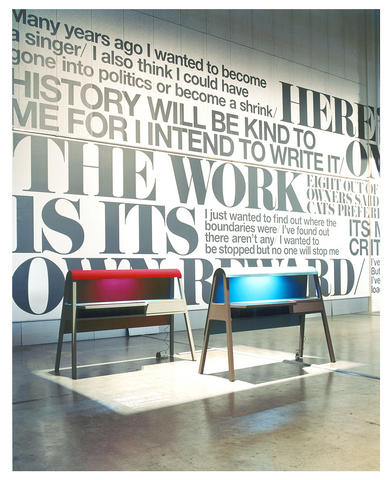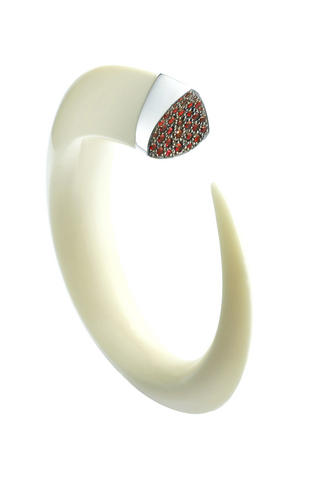The creative industries have been billed as the way of the future, a transformation of the abstruse world of arts and design into a driving force behind commercial development and a vibrant, sophisticated retail culture. This industry has been growing rapidly in the UK, and London has been transformed into "arguably the creative capital of the world," according to David Percival, head of UK Trade and Investment in Taiwan. Love and Money, an exhibition of the best of British design, has set out to showcase the UK's success, and also to establish a platform for cooperation between UK designers and investors in Asia.
The commercial intention of the show is right there in its title. While the purpose of design is certainly to make beautiful things, this is not really enough, as plenty of artists in Taiwan have repeatedly discovered. "When they [designers] do the design, they love it, ... but there is also a big commercial need out there for them to do business and bring in the money," said Amanda Lin (林君玲), the senior commercial officer with the British Trade and Cultural Office who is overseeing the launch of Love and Money in Taipei. The ability to link the love and the money has been crucial to the success of the creative industries in the UK and is a source of envy among many nations that wish to emulate this success. (Creative industries now account for 8.2 percent of GDP in the UK.)
"It is not just about general design. A lot of it is to target the specific needs of Taiwan," said Percival.

PHOTOS: COURTESY OF THE BRITISH COUNCIL
"Taiwan's companies, especially consumer electronics companies, are increasingly becoming brand companies (rather than contract manufacturers). When you are doing your own brand, design becomes much more important. You are no longer just selling on price, but on quality and an image. This is the opportunity for us to work with Taiwanese companies ... . They [Taiwanese companies] don't just work with British designers, but also with British branding companies and marketing companies," Percival said.
The focus on architectural issues is not coincidental either. Percival points to the massive urban development projects that Taiwan is planning. "There is around US$12 billion of projects that are going to be up for grabs in Taiwan over the next five years. ... We are looking at projects like the National Exhibition Center in Kaohsiung and the ideas for a new financial services center around Taipei Main Station."
Love and Money has toured five countries in Asia (and will be moving on to South Korea after it wraps up in Taipei), but according to Percival, the Taiwan show has evolved into the biggest of all, largely due to the great interest of local companies. While the exhibition at Taipei 101 will doubtless present a fascinating showcase of what British designers of every sort are doing, much of the activity for Love and Money will center on the "wrap around events," most notably the UK architecture seminars featuring Adams Kara Taylor, Creative Designs International and Benoy Architects and the Design Forum with Industrial Facilities and Wedgewood, targeted at Taiwan's creative industry professionals.

"These are all commercially proven designers, designers who work in business and run successful design houses or architectural firms. ... It is not just about how important good design is for the quality of life, but that these guys can also make money out of it," Percival said. The success of the UK has been acknowledged in Taiwan in the most telling terms: The number of Taiwanese students going to the UK to enroll in design-related programs has increased by 30 percent over the last three years.
Continental Europe has traditionally been the home of fine design, but over the last decade, the UK has made rapid strides to equal and in many areas supercede established rivals. "It has become incredibly diverse," said Percival. "London is not made up of British designers, it is made up of multicultural designers from all over the world. ... It is all global design, and this makes it very adaptable. If you go into a British design house, you'll find people of every nationality in the world there."


Following the shock complete failure of all the recall votes against Chinese Nationalist Party (KMT) lawmakers on July 26, pan-blue supporters and the Chinese Communist Party (CCP) were giddy with victory. A notable exception was KMT Chairman Eric Chu (朱立倫), who knew better. At a press conference on July 29, he bowed deeply in gratitude to the voters and said the recalls were “not about which party won or lost, but were a great victory for the Taiwanese voters.” The entire recall process was a disaster for both the KMT and the Democratic Progressive Party (DPP). The only bright spot for

Aug. 11 to Aug. 17 Those who never heard of architect Hsiu Tse-lan (修澤蘭) must have seen her work — on the reverse of the NT$100 bill is the Yangmingshan Zhongshan Hall (陽明山中山樓). Then-president Chiang Kai-shek (蔣介石) reportedly hand-picked her for the job and gave her just 13 months to complete it in time for the centennial of Republic of China founder Sun Yat-sen’s birth on Nov. 12, 1966. Another landmark project is Garden City (花園新城) in New Taipei City’s Sindian District (新店) — Taiwan’s first mountainside planned community, which Hsiu initiated in 1968. She was involved in every stage, from selecting

As last month dawned, the Democratic Progressive Party (DPP) was in a good position. The recall campaigns had strong momentum, polling showed many Chinese Nationalist Party (KMT) lawmakers at risk of recall and even the KMT was bracing for losing seats while facing a tsunami of voter fraud investigations. Polling pointed to some of the recalls being a lock for victory. Though in most districts the majority was against recalling their lawmaker, among voters “definitely” planning to vote, there were double-digit margins in favor of recall in at least five districts, with three districts near or above 20 percent in

The great number of islands that make up the Penghu archipelago make it a fascinating place to come back and explore again and again. On your next trip to Penghu, why not get off the beaten path and explore a lesser-traveled outlying island? Jibei Island (吉貝嶼) in Baisha Township (白沙鄉) is a popular destination for its long white sand beach and water activities. However, three other permanently inhabited islands in the township put a unique spin on the traditional Penghu charm, making them great destinations for the curious tourist: Yuanbeiyu (員貝嶼), Niaoyu (鳥嶼) and Dacangyu (大倉嶼). YUANBEIYU Citou Wharf (岐頭碼頭) connects the mainland